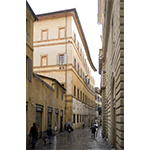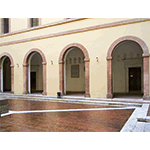Universitą degli Studi di Siena - Rettorato [University of Siena - Rectorate]
The first report of this institution dates from 1240; from a document of the time we learn of the existence of a "provincial" Studio, financed by the Commune, consisting of schools of law, grammar and medicine. On August 16, 1357, Emperor Charles IV of Luxembourg issued a diploma on which he ordered, in response to the requests made by the government of the Twelve, that a "Studium Generale" be established in Siena, "in civil and canon law and in medicine, philosophy, logic, grammar and every other faculty", in which the professors would be empowered to confer all of the academic degrees under the supervision of the Bishop or, in his absence, the Chapter of the Sienese Church. Due to numerous closures and interruptions of the lessons, the institution began to operate regularly only around 1400. With the annexing of the State of Siena to the Duchy of Florence and subsequent to the constitutional reform of 1561, the "Studio" was given new faculties. Under the Grand Duchy of Ferdinand I, the first Chair of the Tuscan Language in an Italian university was instituted, and a Chair of "Simple Medications", that is, of medicinal herbs, was inaugurated.
In 1738 the economist Pompeo Neri was requested by the Lorraine government to "formulate a plan" for developing the University under the organisational and cultural profile. The reform, proposed in 1743, was applied only in 1759, when Neri was given a second assignment to reorganise the "Studio". He proposed a thoroughgoing reform aimed at improving the institution's scientific level. In 1741, to modernise the teaching of anatomy at the University by introducing the experimental method, he called upon the physician from Rimini, Giovanni Bianchi. In addition, he made it compulsory for the professors to enroll in the Accademia dei Fisiocritici in order to establish close scientific collaboration with that institution.
Through a decree of 1808, the Siena "Studio" was transformed into a School of Medicine dependent on the University of Pisa, and only in 1814 was it again reopened. Through a decree of 1851, the higher education of the Grand Duchy was reorganised into a single Tuscan University, called "Studio Etrusco", and was divided between the seats of Pisa and Siena. Only two faculties, jurisprudence and theology, were left in Siena, while the Faculties of Philosophy and Philology, Medicine and Surgery, Mathematical Science and Natural Science remained at Pisa.
With the annulment of the decree of 1851, the Faculties of Medicine and Surgery were re-established in Siena. On October 27, 1859, the innovation of holding competitions for chairs was introduced at the university, with the aim of ensuring better teachers, able to compete with those of the University of Pisa. This decision, which was to be implemented a few decades later by the University of Naples as well, guaranteed that the universities would be staffed by professors no longer selected by the sovereign, but through competitions. Out of seventeen chairs in Law, sixteen in the Arts and Medicine and one in Theology, the Reform established that there would remain "ad arbitrio" of the sovereign the first chairs in theoretical and practical medicine, in civil law, mathematics, the Tuscan language, "Humanity" (Greek and Latin literature) and "Semplici" (medicinal herbs). Classified by the Matteucci law of 1862 as a secondary university, the University of Siena today has eight faculties on site and a Faculty of Literature and Philosophy located in Arezzo.
****************************
Texts by Anna Toscano
English translation by Catherine Frost
Last update 02/feb/2008





